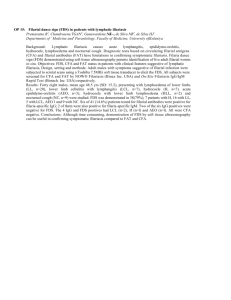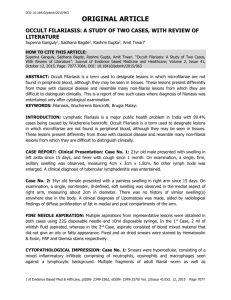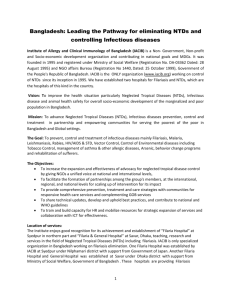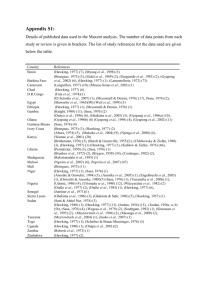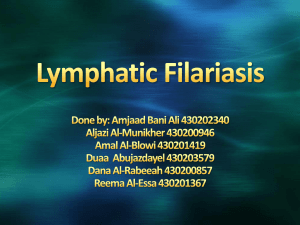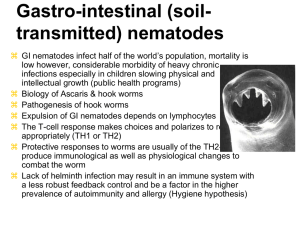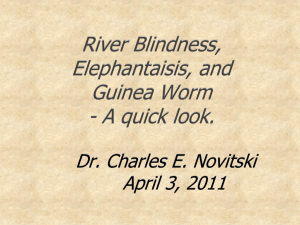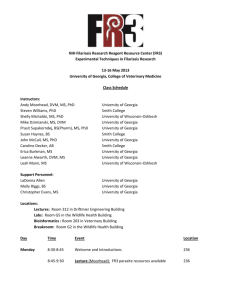filariasis manifestation - phd
advertisement
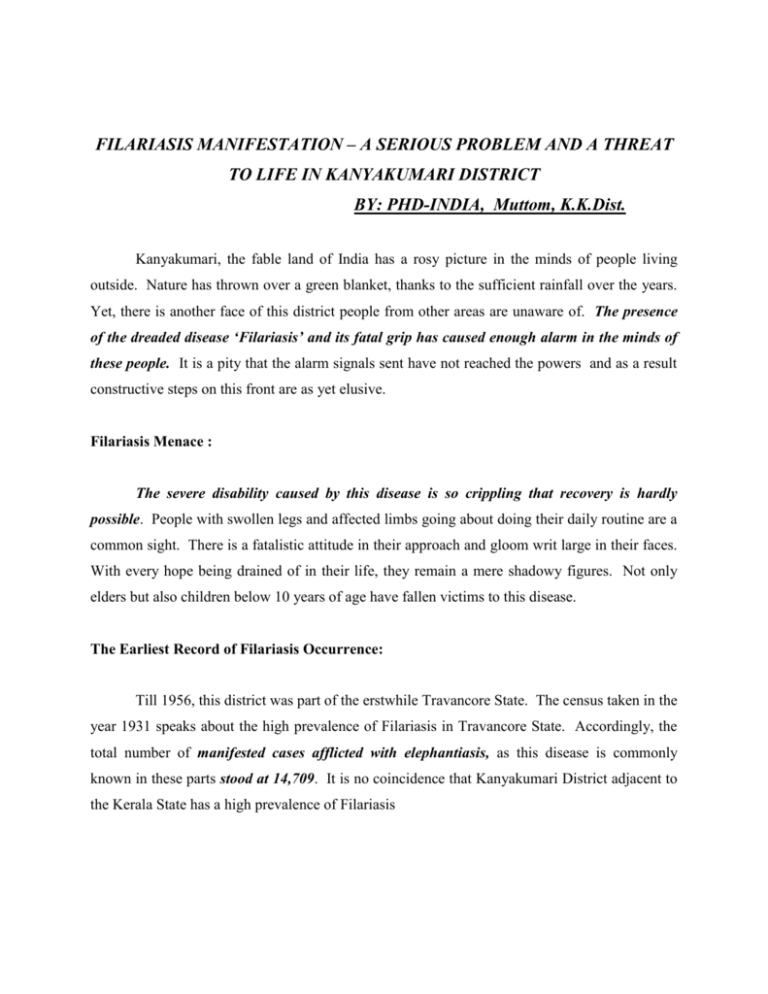
FILARIASIS MANIFESTATION – A SERIOUS PROBLEM AND A THREAT TO LIFE IN KANYAKUMARI DISTRICT BY: PHD-INDIA, Muttom, K.K.Dist. Kanyakumari, the fable land of India has a rosy picture in the minds of people living outside. Nature has thrown over a green blanket, thanks to the sufficient rainfall over the years. Yet, there is another face of this district people from other areas are unaware of. The presence of the dreaded disease ‘Filariasis’ and its fatal grip has caused enough alarm in the minds of these people. It is a pity that the alarm signals sent have not reached the powers and as a result constructive steps on this front are as yet elusive. Filariasis Menace : The severe disability caused by this disease is so crippling that recovery is hardly possible. People with swollen legs and affected limbs going about doing their daily routine are a common sight. There is a fatalistic attitude in their approach and gloom writ large in their faces. With every hope being drained of in their life, they remain a mere shadowy figures. Not only elders but also children below 10 years of age have fallen victims to this disease. The Earliest Record of Filariasis Occurrence: Till 1956, this district was part of the erstwhile Travancore State. The census taken in the year 1931 speaks about the high prevalence of Filariasis in Travancore State. Accordingly, the total number of manifested cases afflicted with elephantiasis, as this disease is commonly known in these parts stood at 14,709. It is no coincidence that Kanyakumari District adjacent to the Kerala State has a high prevalence of Filariasis compared to other districts in Tamil Nadu. Kerala incidentally is one of the states that harbours a high number of Filariasis afflicted persons but the number is decreasing fast due to the awareness and care. Kanyakumari at a Glance: Though the Kanyakumari District of Tamil Nadu State tops in literacy rate, the fact that more than 80% of the people are living in rural areas with inadequate basic amenities for livelihood is unique. The lack of proper sanitation in rural areas and the people’s ignorance over keeping their dwelling places without stagnant water are the twin factors responsible for the spread of this disease in such an alarming manner. Nature’s Gift: This district is endowed with nature’s gifts that include highly fertile soil, and a trail of mountains. The Western Ghat that runs through this district provides for the livelihood of thousands of people. Both the monsoons – Northeast and Southwest – serve the district adequately. This helps storing of water in ponds and streams for most part of the year for agricultural purposes. As the terrain itself has ups and downs, water is stagnant and from which mosquitoes are emanated. They act as safe havens for the breeding of mosquitoes, which are the prime carriers of the disease. The land barriers are so high compared to other districts and are more favour to prevent cyclonic and flood calamities. Little care is given to spotting the areas where breeding possibilities are much. This causes tremendous agony in the minds of the affected population. Socio-Economic Factor: People afflicted with Filariasis in villages are mostly illiterates and suffer hard to make both ends meet. Fever that accompanies this disease recurs often and makes them bedridden. As these people are daily wage earners, their confinement indoors for a couple of days means starvation. Marriages remain a distant goal in the lives of the affected persons. They get no support neither from their kith and kin nor the Government. The condition is most severe in the case of orphans and destitute. Their misery is untenable. Psychological Tormentation: Due to the social stigma attached to this disease, people shy away from the affected persons. The disease, has taken a heavy toll with its psychological tormentation. Many people who have this disease have the fear of social segregation. This compounds the woe as the disease takes root without proper medical attention, early detection, prevention and rehabilitation. Ignorance of the people: Earlier the people are so ignorant that they mistook Filariasis as rheumatic attack. As a result, they took treatment for rheumatism. This ignorance costs them dearly. Apart from the time loss, the amateurish way of getting treatment make the disease grow unabated. Once the disease takes a firm grip and the limbs showing sings of withering, they resign it to fate. They wonder whether life is worth living at all. Superstitious Beliefs: It is curious to note that there are many superstitious beliefs among the people regarding this disease. People still believe that the disease is caused by the curse of St. Thomas, a saint. History records that the Telugu priests while on evangelical work along the coasts of Malabar and Coramondal stoned him to death. Another fanciful thinking is the growing of the tree, screw pine into the water tank and making it poisonous. The similarity exists between the swollen legs of the filarial affected persons and the trunk of screw pine, lends credence to this theory. PHD–INDIA’s Initiative: PHD-INDIA is the only NGO, which has stepped into the shoes of Filariasis victims in the rural pockets of Kanyakumari District. The programme heard by people as ‘Filariasis Control Programme’ is also immediately echoing the name of the NGO PHD-INDIA from the people all around. Other than the PHD-INDIA, there is no NGO working for the cause in all over India. To cite an example PHD-INDIA organised an NGO network at the national level on 10th July 1998. A joint resolution passed by 21 NGOs from 13 states of India has become an important representation to highlight the issues in the higher ups. As a result of this the ‘All India Institute of Medical Science (AIIMS)’, New Delhi has agreed to include Filariasis manifestation as a disability, as it comes under the classification of ‘Locomotors Disability’ as per law. The object and reasons state that the manifestation of Locomotors disability affects the lymphatic system drastically and thereby inflicts symptoms of high fever, pain, swelling, numbness and difficulty in performing certain task. All these symptoms are common and reflected by a person affected by Filariasis disease. When timely treatment is neglected it affects the lymphatic system of the human body and thereby inflicts irreversible damage to its function. Accordingly, on merit of the problem the manifested cases attained chronic stage are liable to be declared as disabled and thus they become eligible to avail all the schemes meant for a disabled person. In addressing the higher-ups and appealing through representations/resolution passed by the Chief functionaries of 21 NGOs represented by 13 states of India; the memorandum sought:- - that the Filariasis manifested attained chronic stage cases are to be included in the physically disabled list and thus provide concessions available for them. - that monthly pension (a relief grant) to be given to these disabled who have attained chronic stage irrespective of age. - that a district level special Hospital to be arranged to give separate Medical attention and Prevention to these disabled persons considering the social stigma attached to this disease. - that Home for these disabled persons is to be made available for them as they are deserted from availing of all privileges in the family and in society. We, the NGOs do understand the increased incidence of Filariasis disability in Kanyakumari District and other parts of India and hereby request your honoured self to consider the Filariasis manifested chronic cases under the list of physically disabled and provide them necessary assistance. Filariasis is an endemic disease prevailing in rural and urban areas at an alarming manner in Kanyakumari District and other parts of India. It causes high incidents of physical disability among men, women and children mostly in rural areas where environmental factors are favouring mosquito breeding. The magnitude of the problems, the required rehabilitation measures like relief schemes are not effected/implemented neither by State Government nor by the Central Government. The statistical data as follows: PHD-INDIA conducted door-to-door survey in 1986 & 87. Accordingly out of a total of 53,012 personas surveyed, 862 (3.5%) were found to be having external manifestations apart from positive cases. Women (511) tend to be more affected than men (351). There is great variation from village to village. Eraniel, which stands first, has a high percentage of 5.52%, while Attoor, which records the lowest rate, has only 0.42%. All the organs of the body are affected with legs registering the highest incidence. Legs 792, Neck 17, Genitals 13, Breast 7, Hands 33, Total: 862. In a blood test at Nattalam * village conducted by the National Filariasis Control Programme (NFCP) for 2 days in February 1988, showed that out of 1054 tested, 66 were positive and 29 were already manifested. Thus more than 9% were found to be microfilaria carriers. PHD-INDIA in collaboration with NFCP and Kerala University conducted blood test for 5 days in Puthukkadai * village showed that out of 350 tested, 36 were positive (10%). Whereas the percentage of microfilaria carriers recorded four municipal towns are 2.8%; 4.5%; 2.6% and 3.3% in Nagercoil, Padmanabhapuram, Colachel and Thuckalay respectively. The survey disclosed that the rural areas of Kanyakumari district are more endemic to filariasis than the urban areas by nearly 2 to 3 times. During the medical survey occurrence of other diseases were also discovered. They are: Tuberculosis 291; Leprosy 220; Cancer 5; Asthma 114; Polio 51; Rheumatic affections 597; Skin infections 221. The main findings of the survey are: a) The poor people (both educationally and economically) are mostly vulnerable to filariasis, as they seldom go for medical check-up and follow-up treatment in the initial stage on the ground that it is expensive and not accessible. b) Women have greater risk of contracting the disease than men. Out of total 862 manifest cases in 10 villages, 511 (59.28%) are women, c) Even young children and adolescents are not spared. The percentage of children (010 years) is 0.26% and that of youngsters (11-30 years) is 1.69%. Filariasis received only step-motherly treatment from the higher-ups More effort and money has been spent on the control of Malaria and Leprosy than Filariasis. PHD-INDIA being the pioneer and the only NGO working for the cause of Filariasis and its victims, the General Secretary Mr. M. Soosai Marian had the opportunity of being instrumental in initiating an amendment in the ‘Persons with Disabilities Act 1995’ by including Filariasis victims under the category of disabled persons. The Draft Proposal for the amendment is ready and we hope for the completion of this process shortly by the Central Government. The health affairs are to be attended timely by the State Government as it comes in the ‘State Health Policy’. Hence PHD-INDIA has also represented the same concern, request and rehabilitation programmes to the Government of Tamil Nadu. PHD-INDIA’s initiatives for Filariasis Control and Rehabilitation: PHD-INDIA has functioned systematically with a well-planned programme for the early detection, prevention, and control of Filariasis treatment and rehabilitation of Filariasis victims. A lot have been done and achieved. Awareness on Filariasis has been created by PHD-INDIA, by means of village meetings, camps, rallies, publications, distribution of pamphlets, cultural shows, publicity through media, conferences, workshops, Film shows, slide shows in cinema theatres, puppet shows, street dramas, tablo procession non-formal education, processions, hunger-strikes and exhibitions. Welfare programmes and schemes have been presented before the Government to wipe the tears of these poor victims. PHD-INDIA has also organised the people by means of Village Councils and a District Level Co-ordination Movement to work for the welfare and development of Filariasis victims. PHD-INDIA employed various methods and activities to create awareness and people’s participation. The Banks have assisted for printing pamphlets and stickers. The services of the NSS students are best utilised for meshing the latrine gas pipe and cleaning of drainages in the villages. Medical camps are often conducted in the Filariasis endemic villages. Free medicines are supplied to the patients through the dispensary at Puthukadai, which is the only solution for medical treatment, and counselling to Filariasis patients in Rural Areas. Anti-larval operations by the people have been initiated in the villages. DEC fortified health salt is supplied to doors in the villages for alternative preventive source of Filariasis eradication. Health conferences are conducted chiefly to make the civil servants and representatives of the people aware of the serious dimension of the disease. Rural sanitation is promoted and improved by constructing 400 individual latrines in the endemic villages. Getting infected by filariasis is receiving a painful slow death warrant. After infection recovery is hardly possible. Husband aborts wife, son detests mother, but not PHD-INDIA. It requires the heart of a lion to be with them and treat them. Every step taken in the prevention and controlling of the disease and also the rehabilitation, will have lasting effect in consoling the feelings of the filariasis disabled persons. The rural people are longing for the opportunity. They are very much eager about the fate of their children and eager to avail medical treatment, provided it is within their reach. A stage will reach when Kanyakumari District will be remembered for this dreaded disease instead of the numerous tourist attractions. The fast spreading of the disease has the ominous signs that nobody will be immune from its clutches. Even if one is not able to come up immediately with some miracle drug or vaccine to handle the problem of filariasis, we can all do something in our own levels to involve people around us to help respond to the problem. We can help to create environments where the disease – carrying mosquitoes get controlled/eradicated. The persons infected by filariasis are to be detected and medically treated at their doorsteps. The fate of these chronic patients who have no hope for remedy is a big question! Their rhabilitation is a challenge! The handicaps faced by the affected population are beyond description! Calcutta needed a Mother Theresa to rehabilitate the slum people. Do we need another Mother Theresa to work for the Filariasis affected persons in the southern tip of India? Or could we do something to relieve the pain and suffering of these people?
